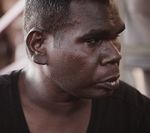Media Release - National Film and Sound Archive
←
→
Page content transcription
If your browser does not render page correctly, please read the page content below
Media Release
UNDER EMBARGO UNTIL 12:01AM, 30 OCTOBER 2018
Gurrumul, PowderFInger and Goanna celebrated
in this year’s Sounds of Australia
Female pioneers Pilita Corrales and Margret RoadKnight
also added to Australian recorded sound honours list
From one of the first women to have a hit song in the Australian charts, Pilita Corrales, to the highest selling Aboriginal album by
Gurrumul, 10 essential sounds that helped define Australian history and culture have been added to the National Film and Sound
Archive of Australia’s (NFSA) Sounds of Australia.
Other inductees include Goanna’s track about Aboriginal land rights, Solid Rock; Margret RoadKnight’s empowering Girls In Our
Town; Powderfinger’s hit These Days; the popular tongue-twisting song I’ve Been Everywhere by Lucky Starr; and Binny Lum’s extensive
collection of celebrity interviews.
The 2018 Sounds of Australia are, in chronological order:
1905 Caro Mio Ben - Ada Crossley: A prominent turn-of-the century opera singer.
1926 Freshie/After the Dawn - Sydney Simpson and his Wentworth Café Orchestra: After the Dawn is the first
entirely Australian recording, composed, performed, recorded and pressed by Australians.
1955-1967 Binny Lum Collection - Binny Lum and interviewees: The Melbourne broadcaster’s collection of interviews
includes exclusives with The Beatles, Barbra Streisand and countless Australian and global stars.
1959 Come Closer to Me - Pilita Corrales: A Filipino woman singing in Spanish was one of the first female singers to
make the Australian charts with a locally produced record!
1962 I’ve Been Everywhere - Lucky Starr: More than 131 versions of this tongue-twister exist, confirming its universal
appeal and ongoing popularity.
1976 Girls in Our Town - Margret RoadKnight: An empowering song about the trials and tribulations of teenage girls
during the 1970s era of women’s liberation.
1982 Solid Rock – Goanna: A protest message that resonated with the Australian public.
1992-2008 Songlines: Songs of the East Australian Humpback Whales - Mark Franklin: Featuring Migaloo, the famous albino
humpback whale.
1999 These Days –Powderfinger: One of the alternative band’s most popular tracks.
2008 Gurrumul – Gurrumul: the best-selling Aboriginal and Torres Strait Islander music album in Australian history.
J Yunupingu, on behalf of Gurrumul’s family, said of the announcement: ‘The album Gurrumul represents identity of all Yolngu people
of North East Arnhem. Dr G has sung in five different Yolngu languages and the publication of these songs is a treasure and a gift for all
Australians and people all over the world.’
Skinnyfish music’s Mark T. Grose and Michael Hohnen (Gurrumul’s manager and producer respectively) added: ‘We are honoured to have
this landmark album added to the Sounds of Australia. As a label we are proud to be able to contribute to the artistic estate of this country,
and present Dr G Yunupingu’s voice and musicianship - a treasure in its own right- to the greater population. Dr G. Yunupingu was a
beautiful, gentle and significant force, whose important language, powerful voice and spirit embody a deeper culture of this country.’
Goanna’s Shane Howard said: ‘It means a lot to know that Solid Rock, which set out to shine a light on the historical injustice suffered by
Aboriginal Australians, is now to be formally set in stone as a part of Australian history. I was deeply moved when I received the news.’
Powderfinger said: ‘It’s a great honour for us to have our music included amongst some of the finest ever made in this country in the
NFSA’s Sounds of Australia. These Days almost wrote itself and was based on a very simple motif that circles around the same four chords
and lyrics that lament time and the pressure it places in our daily lives. The repetition was intentional and reinforces its simple message.
Given that it was never a single, it is surprising that it has become one of our most enduring and loved songs.’
NFSA_0709_10/2018
In 2007 the NFSA launched Sounds of Australia, the honours list of Australian recorded sounds that changed history, or defined our
evolving cultural identity. They are recognised for their cultural, historical and/or aesthetic achievements. Being part of Sounds of
Australia means that the recordings will live on at the NFSA, for future generations to discover and enjoyThe following talent are available for interviews:
·· NFSA Sound Curators Thorsten Kaeding and Nick Henderson
·· Michael Hohnen, Gurrumul’s producer
·· Pilita Corrales
·· Shane Howard (Goanna)
·· Margret RoadKnight
·· Sharon Terry, Binny Lum’s daughter
·· Lucky Starr (Leslie William Morrison)
·· Margery Missen, author and Ada Crossley biographer
To arrange an interview or for more information please contact:
MIGUEL GONZALEZ, P: (02) 8202 0114 or 0404 281 632, miguel.gonzalez@nfsa.gov.au
BRANKA PRODANOVIC, P: (02) 6248 2248, branka.prodanovic@nfsa.gov.au
IMAGES AND CLIPS AVAILABLE FOR DOWNLOAD: http://bit.ly/SoA2018media
ABOUT SOUNDS OF AUSTRALIA
Each year, the Australian public nominates new sounds to be added with final selections determined by a panel of industry experts.
They can be popular songs, advertising jingles, famous speeches, radio broadcasts, or any other sound recordings – as long as they’re
Australian and more than 10 years old. Nominations are now open for 2019.
SOUNDS OF AUSTRALIA 2018
Caro Mio Ben, Ada Crossley (c.1905)
‘Caro Mio Ben’ was recorded in the United States on 30 April 1903; it was the first
recording in Victor Gramophone Co.’s pre-eminent Red Seal Celebrity series. It is a
popular concert aria composed in 1783 by a member of the Giordani family. Crossley
was a prominent Australian opera singer of the 1890s-1910s and a member of the
Marchesi School, along with Dame Nellie Melba. She undertook popular tours of
America (1902-03 and 1908-09), Australia (1903, with Percy Grainger in support) and
South Africa (1904), as well as performing at a range of charity war concerts.
Freshie; After the Dawn, Sydney Simpson and his Wentworth Café Orchestra
(1926)
On 23 October 1926, the Daily Telegraph reported that the Columbia Company had
released the first record pressed and recorded at their Homebush studio and factory
– and made the first entirely Australian recording. The 10” shellac disc consisted
of two items played by Sydney Simpson and his Wentworth Cafe Orchestra: the
popular ‘After the Dawn’ waltz by Jack O’Hagan, and a foxtrot, ‘Freshie’, by Jesse Greer
and Harold Berg. ‘After the Dawn’ was the first entirely Australian recording, being
composed, performed, recorded and pressed by Australians. Many thousands of
Australian performances were later recorded and pressed at the Homebush facility up
until 1992, when the factory closed with the cessation of production of vinyl records.
Binny Lum Collection, Binny Lum and interviewees (1955-1967)
Actor, scriptwriter, accompanist, compere, television host and radio presenter - Binny
Lum was a pioneer whose extraordinary career in radio and television broadcasting
spanned five decades, from 1934 to 1984. She hosted Channel Nine’s first ever daytime
television talk show, Thursday at One with Binny Lum, in 1957. Binny went on to host
one of radio’s first magazine format programs on 3XY in Melbourne, where she
interviewed many high-profile people before venturing overseas to New York and
London, interviewing Barbra Streisand, Dame Joan Sutherland, Richard Attenborough
and, most famously of all, The Beatles. The Binny Lum Collection includes over 175
interviews recorded throughout her career.SOUNDS OF AUSTRALIA 2018 Come Closer to Me, Pilita Corrales (1959) Pilar ‘Pilita’ Garrido Corrales was one of the the first women to make the Australian pop charts with a locally produced record - her hit single ‘Come Closer to Me’, in 1959. Born in the Philippines, Pilita began her distinguished recording career in Australia, after being shipwrecked off the coast of Arnhem Land. In Sydney Pilita released ‘Come Closer to Me’ with Astor Records in November 1959; it was a cover of ‘Acércate Más’, a 1946 track by Cuban songwriter Osvaldo Farrés. Pilita recorded at least three LPs in Australia and became an early television star, before returning to the Philippines in 1963. She has starred in many films and on television, recorded more than 135 albums and appeared as one of the judges in the Philippines edition of The X Factor. I’ve Been Everywhere, Lucky Starr (1962) This 1962 hit was written by Australian country singer Geoff Mack in 1959 and made popular by Lucky Starr in 1962. It has such universal appeal that more than 131 versions exist - with lyrics adapted for the United States, New Zealand, the UK and Ireland, Canada, Finland, Germany and many other locations. The novelty song as originally written listed 94 Australian towns and locations sung at speed, and proved a hit for Leslie William Morrison (known professionally as Lucky Starr), reaching number 1 in the Sydney charts. Soon after Mack wrote an American version, which was a number one hit for Hank Snow. Other famous performers include Johnny Cash, Lynn Anderson and Willie Nelson. The tongue-twisting lyrics, rapid fire delivery and international success have ensured that this novelty song has remained popular in the Australian imagination long after its initial chart success. Girls in Our Town, Margret RoadKnight (1976) Released as a single in January 1976, Margret RoadKnight’s version of Bob Hudson’s ‘Girls in Our Town’ reached the Top 20 of the Kent Music Report Singles Chart. Written by Hudson, the song describes the often limited opportunities for teenage girls living in Newcastle, with few career options and limited entertainment. However, the lyrics have a universality to them, which connects them to a broader experience of suburban and rural life for young women. RoadKnight included the single on her third album, Margret RoadKnight, which was issued in October 1976. It has become a performance favourite in a career that spans more than five decades across a wide variety of styles, including blues, jazz, gospel, comedy, cabaret and folk. Solid Rock, Goanna (1982) ‘Solid Rock’ deals with issues of land rights for Aboriginal and Torres Strait Islander people and was the lead single from Goanna’s debut studio album, Spirit of Place. According to songwriter Shane Howard, the inspiration for the song came on a 10-day camping trip at Uluru in 1980, where he saw ‘an incredible injustice that needed to be dealt with … I had to reassess my whole relationship with the land and the landscape, and understand that we had come from somewhere else, and we had disempowered a whole race of people when we arrived.’ The protest message resonated with the Australian public, with the single peaking at number 3 on the Australian Kent Music Report and winning Best Debut Single at the 1982 Countdown Music and Video Awards.
SOUNDS OF AUSTRALIA 2018
Songlines: Songs of the East Australian Humpback Whales, Mark Franklin
(The Oceania Project) (1992-2008)
Songlines features humpback whale song recordings taken off the coast of Eastern
Australia during their cycle of migration between their birthplace in the Great Barrier
Reef and their Antarctic feeding areas. Track 3 (‘1998 Songline’) features Migaloo,
the rare albino humpback whale that, when first sighted, was believed to be the only
white whale in the world. The recordings by Mark Franklin are part of The Oceania
Project, a long-term research project undertaken by Franklin’s parents, Dr Trish and
Dr Wally Franklin, on humpback whales. It looks at the whales’ social behaviour
and organisation, abundance and reproduction, and has provided new insights into
eastern Australian humpback whales. The recordings also help raise awareness of the
need for the rehabilitation, preservation and conservation of humpback whales and
Migaloo, the rare albino humpback whale
their ocean environment.
These Days, Powderfinger (1999)
Powderfinger’s ‘These Days’ has been described by the band as ‘one of their most
simple, enduring and popular works’. Lyrically the song deals with bowing down to all
the responsibilities and obligations of life. It also responded to an emotional scene of
redemption, vengeance and justice in the film Two Hands (Gregor Jordan, Australia,
1999), for which it was written. ‘These Days’ was initially released as the B-side to the
single ‘Passenger’ in 1999, then as the lead track on the film soundtrack. The success
of the song saw it top the triple j Hottest 100 chart in 1999, and it was subsequently
awarded Song of the Year at the 2000 Music Critics’ Awards. Powderfinger later re-
recorded ‘These Days’ on their fourth studio album, Odyssey Number Five (2000). In
2009, These Days was voted No. 21 in the triple j Hottest 100 of all time.
Gurrumul, Gurrumul (2008)
Gurrumul was the debut solo album for singer, songwriter and multi-instrumentalist
Geoffrey Gurrumul Yunupingu (1971-2017), referred to as Dr G Yunupingu since his
death. It is the best-selling Aboriginal and Torres Strait Islander music album in
Australian history, having been awarded triple platinum status. The University of
Sydney granted Dr G Yunupingu an Honorary Doctorate of Music in 2012. Blind from
birth, his musical education was largely self-taught and through cultural immersion;
he learned drums, keyboards, guitar, didjeridu, foot stomping and calling, whooping,
vocalisation of traditional songs, and more. Gurrumul is performed in a mixture of
both Yolngu languages and English, with lyrics that often refer to traditional lore, and
relationships with family and nature. The album peaked at No. 3 on the ARIA chart
but reached No. 1 on the independent chart and was an international success on world
music charts. At the 2008 ARIA Awards the album won Best World Music Album and
Best Independent Release, and also won three Deadly Awards for Artist of the Year,
Album of the Year and Single of the Year for the track ‘Gurrumul History (I Was Born
Blind)’. The autobiographical single represents many of the themes that connected
Dr G Yunupingu’s music to his audience: his bilingual vocals, his personal story of
blindness, and living across cultures.You can also read



























































